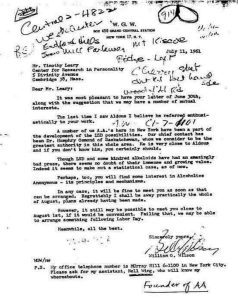 Exploring the Unlikely Correspondence Between Timothy Leary and Bill Wilson
Exploring the Unlikely Correspondence Between Timothy Leary and Bill Wilson
In the early 1960s, an unexpected correspondence unfolded between two prominent figures: Timothy Leary, a psychologist and leading advocate for psychedelic research, and Bill Wilson, the co-founder of Alcoholics Anonymous (AA). This exchange offers a fascinating glimpse into a moment when two different worlds—those of psychedelic exploration and spiritual recovery—briefly intersected. A letter from Wilson to Leary, dated July 11, 1961, reveals a surprising openness from Wilson towards the potential therapeutic use of LSD, a stark contrast to the typical perception of AA’s conservative approach to sobriety and addiction recovery.
Background: Two Pioneers in Their Fields
Timothy Leary was known for his groundbreaking research into psychedelics at Harvard University, where he explored the psychological and therapeutic benefits of substances like LSD. Leary’s work was at the forefront of a counterculture movement that championed expanded consciousness and the breaking down of societal norms. His advocacy for the use of psychedelics as a tool for personal growth and healing made him a controversial figure in the scientific and public spheres.
Bill Wilson, in contrast, was a recovering alcoholic whose profound spiritual experience during his own battle with addiction led to the founding of Alcoholics Anonymous in 1935. AA promotes a program of recovery that emphasizes spiritual awakening and mutual support through its Twelve Steps. Wilson’s own recovery journey was deeply influenced by his “white light” spiritual experience, which he believed was a divine intervention that helped him achieve sobriety.
 The Content of the Letter
The Content of the Letter
In the letter to Leary, Wilson expresses genuine interest in the potential of LSD to facilitate spiritual experiences similar to those he believed were crucial in overcoming addiction. Wilson wrote, “A number of us A.A.’s here in New York have been a part of the development of the LSD possibilities,” indicating that there were discussions within AA about the potential benefits of psychedelics in the recovery process.
Wilson references his connection with Dr. Humphry Osmond, a psychiatrist and one of the pioneers of psychedelic therapy, who was known for his work with LSD in treating alcoholism. Wilson suggests that Leary and Osmond’s research might align in exploring how LSD could be used to induce spiritual awakenings that help individuals struggling with addiction achieve sobriety.
Interestingly, Wilson acknowledges the negative perception of LSD in the media at the time, stating that “LSD and some kindred alkaloids have had an amazingly bad press,” but also highlights their “immense and growing value.” This shows Wilson’s willingness to consider alternative, albeit controversial, approaches to spiritual and psychological healing, even within the context of AA’s more traditional views on sobriety.
Dear Mr. Leary:
It was most pleasant to have your letter of June 30th, along with the suggestion that we may have a number of mutual interests.
The last time I saw Aldous [Huxley] I believe he referred enthusiastically to your work.
A number of us A.A.’s here in New York have been a part of the development of the LSD possibilities. Our chief contact has been Dr. Humphry Osmond of Saskatchewan, whom we consider to be the greatest authority in this whole area. He is very close to Aldous and if you don’t know him, you certainly should.
Though LSD and some kindred alkaloids have had an amazingly bad press, there seems no doubt of their immense and growing value. Indeed it seems to make out a statistical case, as of now.
Perhaps, too, you will find some interest in Alcoholics Anonymous—its principles and mechanisms.
In any case, it will be fine to meet you as soon as that can be arranged. Regrettably I shall be away practically the whole of August, plans already having been made.
However, it still may be possible to meet you close to August 1st, if it would be convenient. Failing that, we may be able to arrange something following Labor Day.
Meanwhile, all the best.
Sincerely yours,
Bill Wilson
(William G. Wilson)P.S. My office telephone number is Murray Hill 6-1100 in New York City. Please ask for my assistant, Neil Wing, who will know my whereabouts.
Founder of AA
The Significance of This Correspondence
This exchange between Wilson and Leary is significant for several reasons:
- An Intersection of Philosophies: The letter illustrates a unique intersection between two very different approaches to understanding and transforming human consciousness. While Leary was exploring the expansion of consciousness through psychedelics, Wilson was advocating for spiritual transformation through personal reflection and communal support within AA. Despite their different methods, both were seeking similar outcomes: personal growth, healing, and spiritual enlightenment.
- Open-mindedness in Recovery Approaches: Wilson’s openness to exploring new and unconventional methods, such as psychedelic therapy, highlights his commitment to understanding all potential avenues for helping individuals recover from addiction. This curiosity aligns with his belief that profound spiritual experiences could be a key to overcoming addiction, a belief rooted in his own recovery journey.
- Controversy and Divergent Paths: While Wilson showed interest in LSD’s potential, his views were likely controversial both within and outside AA. Many members of AA, grounded in a more traditional understanding of sobriety, may have been uncomfortable with the idea of using mind-altering substances to facilitate recovery. This divergence between AA’s spiritual approach and the psychedelic exploration championed by Leary reflects broader cultural and scientific debates about the best methods for psychological and spiritual healing.
- Legacy and Impact on AA: Although Wilson’s interest in psychedelics did not lead to their integration into AA’s practices, the correspondence reflects the experimental spirit that characterized some of AA’s early developments. It also shows the organization’s ongoing search for effective recovery methods. Wilson’s willingness to engage with Leary suggests a more nuanced view of recovery than is often attributed to AA’s founders.
Reflecting on the Potential of Psychedelics in Recovery
Today, the idea of using psychedelics as a tool for addiction recovery is gaining renewed interest, with modern studies exploring the potential benefits of substances like psilocybin and MDMA for treating various mental health issues, including addiction. Wilson’s brief but meaningful exchange with Leary foreshadowed this current resurgence in interest, suggesting that there may be multiple paths to achieving spiritual awakening and recovery.
This correspondence serves as a reminder of the importance of keeping an open mind when exploring new methods for healing and growth. It encourages us to consider all possible tools—whether spiritual, therapeutic, or even pharmacological—that might help those struggling with addiction find their way to recovery.
The brief correspondence between Timothy Leary and Bill Wilson is a fascinating chapter in the history of addiction recovery and psychological research. It provides insight into a time when new ideas about consciousness and healing were being actively explored and debated. While AA continued along a more traditional spiritual path, Wilson’s curiosity about psychedelic research reflects a broader, more open-minded approach to the possibilities for spiritual and personal growth. As we continue to explore new methods for healing, this historical exchange reminds us that recovery is a journey with many possible routes, and that an open mind can be one of our most valuable tools.

 The Content of the Letter
The Content of the Letter


